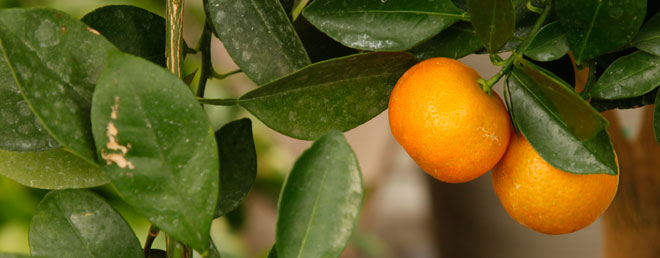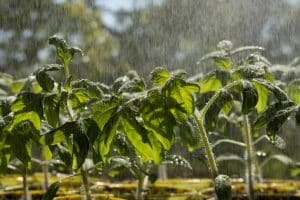Grow Your Own Citrus: Even in Alberta
by Rob Sproule
The Best Varieties to Grow Caring for Your Citrus Calamondin Oranges
According to Feng Shui, a citrus plant wards off negative forces in the home and provides a beacon of positive energy. When you smell a Calamondin in intoxicating bloom and see its rich, luscious leaves, it’s easy to understand why.
Citrus has an unfortunate reputation for being difficult to grow. While it’s true that you’re not going to have an orange grove in your backyard, anyone with a bright window and a little love to give can enjoy citrus in their home throughout the year. Citrus’ tendency to bloom and fruit during the winter makes them a holiday favourite. They are also a traditional gift given over the Chinese New Year, which falls on Jan 23 in 2012.The Best Varieties to Grow:
Many varieties are well suited to growing indoors. Acidic fruits like Calamondin oranges, Lemons, and Limes are miniature plants, not growing past 3-4 ft, that are well suited to normal household conditions. Sweet fruits, like naval and blood oranges, grapefruits and kumquats need too much space, light, and heat than our homes can give them. You’ll still need to get your breakfast grapefruits from the supermarket. Availability can be elusive, so call around to large Garden Centers to find citrus for sale. Before you buy, check for yellowing leaves which indicate improper watering. Give it a gentle shake and if leaves flutter down it probably hasn’t been properly cared for in the store.Caring for your Citrus:
Luckily, acidic citrus varieties thrive in temperatures of about 20 degrees C during the day and a couple degrees cooler at night. If it’s too cool you will know when the fruit doesn’t ripen. Try not to subject it to anything under 7 degrees, and of course frost is lethal. Give your citrus as much light as possible. Even though you won’t need to add a supplemental grow light for an acidic type, it will still need 6 hours of bright light daily, which can be a tall order in Alberta winters. Put it in the sunniest window you have. Like most tropical plants, citrus like to be moist but not wet. Expect them to consume more water when in fruit/bloom and during the heat of the summer. Water with room temperature water when the first 5-7 cm of the soil is dry. Soak the soil thoroughly to rinse accumulating salts away. Afterwards, make sure to empty the saucer to avoid the dreaded wet feet. Don’t be in a rush to transplant. Citrus like to be somewhat snug and root bound in their containers. If you buy it in a grower’s pot, which aren’t always very attractive in the living room, place the pot in another container with decorative rocks around it. Misting your citrus every few days, especially if you don’t have a humidifier to temper the furnace’s dry heat, will keep it lush and help it fight off insect infestations. Make sure it’s not above a heat register or the leaves will quickly dry out. If you have hard (alkaline) water, consider using distilled water or adding about a tablespoon of vinegar to a gallon of water to adjust the pH. Citrus are heavy feeders and need regular fertilizing in order to yield. You can use 20-20-20 (which contains important micronutrients which are very important, like iron and magnesium), or a specialty citrus fertilizer. Pale leaves with green veins are evidence of nutrient deficiency. During the summer, you will probably want to enjoy your potted citrus outside with your other containers. With our intense Alberta sun, however, you may need to protect it from the afternoon scorch.Calamondin Oranges:
Calamondins because they are the most popular and easy to grow indoor citrus. As the most ornamental variety, they also make a beautiful house-guest. Although not true oranges, Calamondins produce scores of 4 cm fruit which are preceded by intoxicating yet delicate white flowers. The fruit is edible (peels and all), and although it’s sour it’s perfect for making marmalades or adding to summer drinks. They make a zesty lemon substitute. You will need to be the “bee” and pollinate your Calamondin. It sounds harder than it is. Simply rub a small, dry paintbrush or Q-tip in all the flowers to spread the pollen around. Don’t be in a rush to pick them. The ripening oranges are gorgeous on the branch and last for months, sweetening gradually as they hang.















